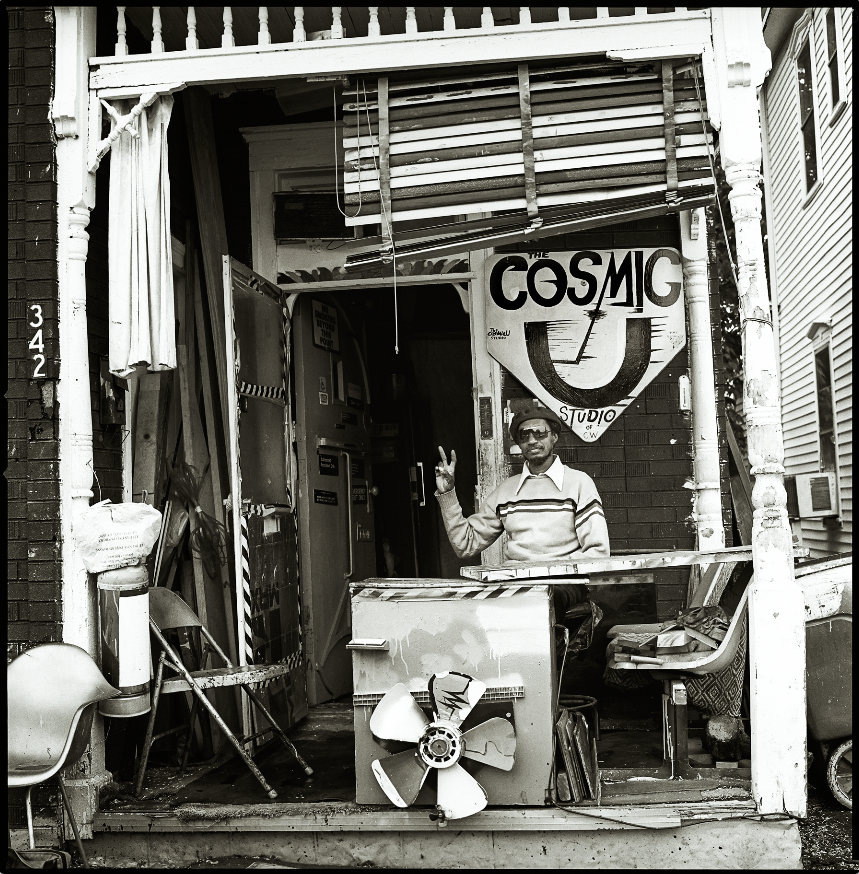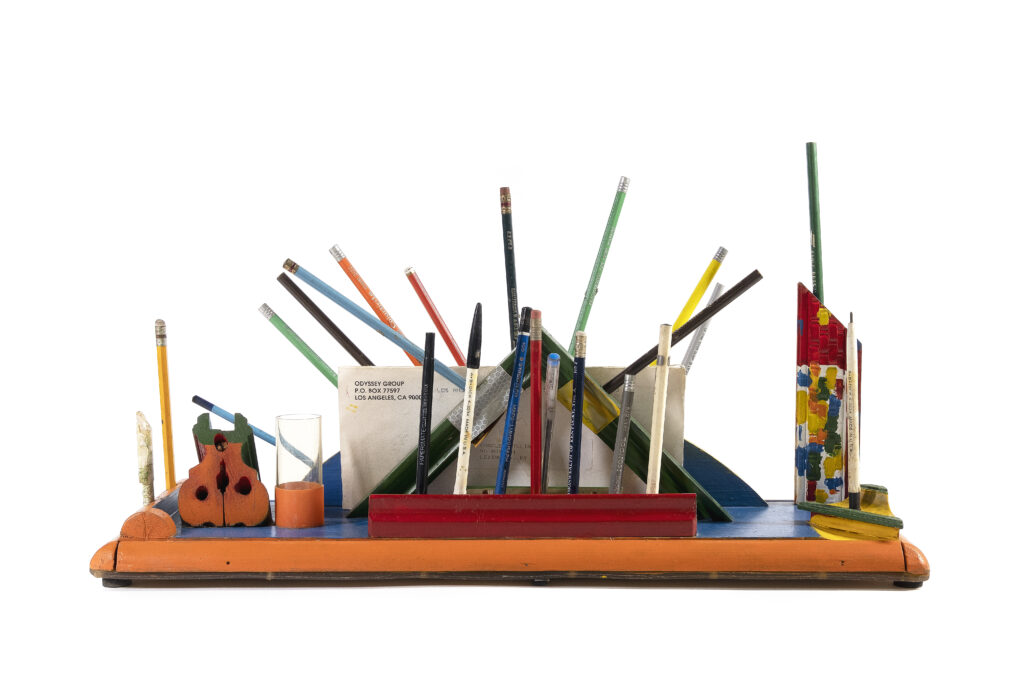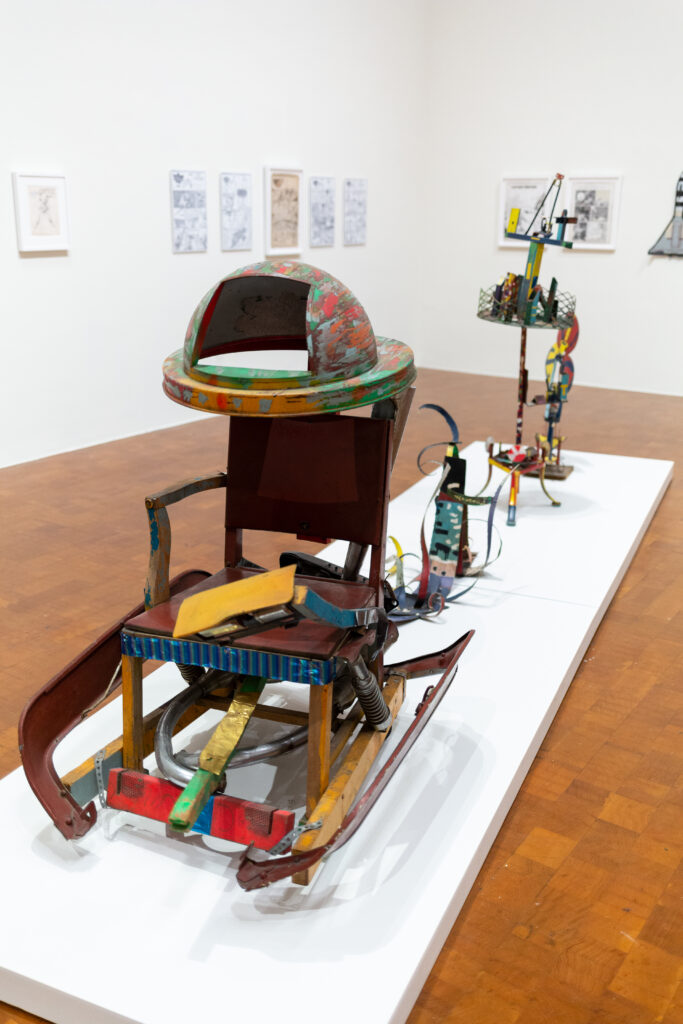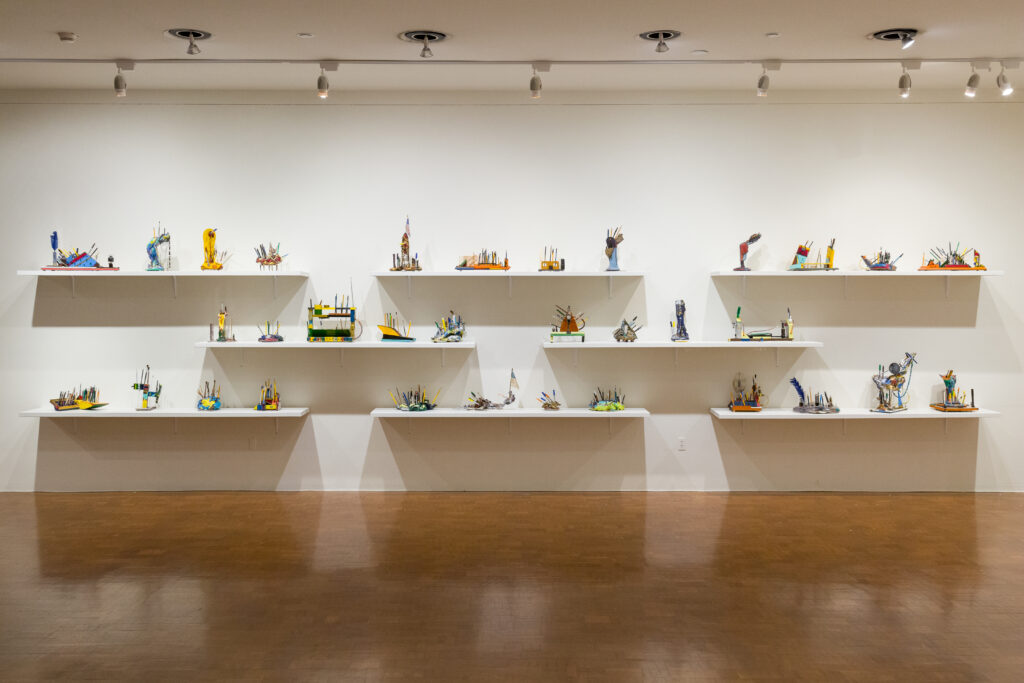“The Life and Death of Charles Williams,†a jam-packed retrospective at the University of Kentucky Art Museum, contains probably more than fifty works by the late artist. Born in a holler in 1942, Williams made his living through low-wage work, was largely self-taught, filled his Lexington property with bright painted handmade things, and died tragically (from, as the exhibition’s materials somewhat dispassionately relate, “AIDS-related complications and starvationâ€) in 1998, at the age of 56. If Williams’ biography strikes one as a thorough trope of the “outsider,†the quality of his art extends far beyond the limits of this designation. His sculptures, especially, list and jut with the barely serious energy common to much art from the twentieth century’s last few decades. Even though he worked for the most part insularly, Williams seems to have had a developed enough sensibility to have invested his art with an aspect of the general character of its period. What’s more important, though, is that Williams also possessed a powerful enough vision to have allowed many of his individual works to transcend this specificity in our experience of them.
“Life and Death†conveys the whole gamut of Williams’ artistic production. In fact, it seems to comprise close to every one of his surviving artworks: sketches for unpublished comic books fill a wall and a half, captivatingly amateurish renderings of birds and superheroes on big dirty boards take up several more, the floor is strewn with protuberant tilting sculptures. At the far back of the gallery some thirty assemblages – pencil holders made out of wood scraps and purloined motherboards – offer up a sort of conclusion to the view of Williams’ creations as making up some eclectic whole that the show provides.

Image: Melissa Watt, Cosmic Peace, 1993, digital scan from negative. A black and white photograph of a man on a porch. Courtesy of the artist.
Though I’d like to focus on his sculptures, Williams’ two-dimensional works – hand-drawn, sometimes collaged comic book pages and colorful paintings of, curiously, either tropical birds or cartoon characters – deserve mention. The former are delightful curiosities, and the latter are occasionally superb, if underdeveloped, pictorial inventions. What’s most worthwhile in the comics is their wont to lapse from storyboarding into formal indulgency. In a panel from the space epic Captain Thirteen, a carefully foreshortened ship shoots back from the picture plane into a cosmos made out of patterned paper collaged onto the composition. It shows Williams to be a thoughtful student of comics’ sensitivity for the fundamental import of the figure-ground relationship, as well as an understanding of the capacity for meaning latent in the most basic functions of lines.
All this is elevated to a point of ridiculous salience in Williams’ superhero paintings; the best of which shows a Superman standing contextless against a light beige ground. His muscles are delineated by black squiggles that, too thick and sinuous to maintain correspondence with their figure’s actual physical characteristics, flatten into a system of abstract forms that seem to hover just above his body. The unwillingness of these sculpting elements to actually define shapes or suggest recession creates a dissonance between the representation and the means through which it’s represented. Looking at the picture is an interruption of looking at what it shows, but an interruption grounded in the formal logic of this type of picture (comic-book contouring and pert linearity). This effect is made more palpable by the universal recognizability of the subject: Superman, but very weirdly denatured.

In the best of Williams’ sculptures, all of which are bursting appropriations of common objects like tree stumps, liquor bottles, trash bins, and dolls, the aesthetic potential of “denaturing†is realized to a degree only hinted at in the paintings. The sculptures elevate their odd or uncanny qualities beyond the point merely of alienation. They elaborate a self-supporting formal logic, conveying a sense of completeness not entirely present in the two-dimensional works.
As must any successful collage, Williams’ assemblages consider the prior meanings of their many constituent parts so as to suppress or emphasize these meanings selectively in the combinatory process that results in their total form. Unlike a more socially forward assembler like, say, Betye Saar, Williams seems to have privileged this totality of each work over the significance of each of its components; the personal or cultural meanings of his materials are often deeply suppressed (though never entirely effaced) by means of their composition into a non-signifying network of shapes and angles. This aspect of Williams’ sculptures is emphasized, rather than troubled, by their intended functionalism. Many were meant to serve as pencil holders, though the various utensils that poke out from every side of them are invariably absorbed into each work’s overall physiognomy, like hatch marks into the image an etching presents.

The most consistent and significant engine of meaning in these assemblages is their directionality. This is most evident in the four works – the best Williams ever pulled off – which the exhibition labels the “arks†or “spaceships.†(It appears as though Williams left them untitled, though these names certainly make sense within the comic-book cosmology the exhibition cultivates.) Each is made of a metal leg angled at about seventy degrees with a board placed flatly on top, to whose surface is stuck a miscellany of mostly wood scraps but also little plastic things and many pencils, all of which are painted in globs, dots, or splashes of bright colors like yellow and pink. Though the objects on top of the boards appear to have been randomly arranged – an appearance facilitated by the sculptures’ aimless, all-over coloration – most are in fact angled opposite the tilt of their sculpture’s support. This generates an effect of balanced movement as if the arks are lurching forward, their accouterments swaying back and forth like seagrass. From the moment this structuring device is recognized, other, more subtle aspects of the sculptures’ crazy order reveal themselves to the viewer: affinities and contrasts between colors that appear slapdash at first; the perfect placement of a squat wood block alongside a sloping one; rhythmic counterpositions of backward-leaning pieces against the sculptures’ forward thrust; the way each sculpture’s top surface is chunked out into a network of empty space not unlike the decorative maze of Superman’s musculature.

One gets the sense that Williams, evidently very sharp but undereducated, sculpted as a means of understanding a world whose machinations were closed off to him. For much of his adult life, he worked as a janitor at IBM. His wonky constructions, built in large part out of office materials swiped from his superiors’ desks after hours, certainly look uncannily technological, like manifestations of the deep psychology of a thinking computer. This is especially the case with his pencil holders, of which the show contains a few dozen. Williams made these works throughout his last couple of decades, while the role of computers in American social and political life was increasingly salient. As a curious nonexpert in high technology’s midst, Williams must have seen in the machines he swept up around a mixture of creative potential and existential threat. This gives his sculptures an almost mantic quality, as well as a dimension of historical interest apart from their significant artistic achievement. More so than the guarded stuff in Fredric Jameson’s famous idiom of the “technological sublime,†however, Williams’ sculptures seem to convey basic truths about human creativity’s confrontation with the limits and dangers of its own highest flourishing. But since they’re by and large good works of art, they do so ambiguously.
“The Life and Death of Charles Williams” exhibit is on display at the University of Kentucky Art Museum through November 22, 2022.
Top image: Installation view of “The Life and Death of Charles Williams” at the University of Kentucky Art Museum. Photo credit: Alan Rideout.




